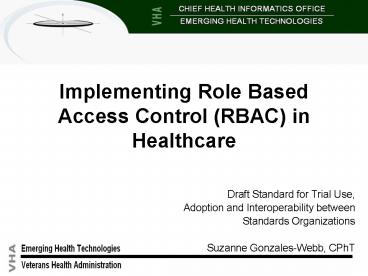Implementing Role Based Access Control RBAC in Healthcare PowerPoint PPT Presentation
1 / 16
Title: Implementing Role Based Access Control RBAC in Healthcare
1
Implementing Role Based Access Control (RBAC) in
Healthcare
- Draft Standard for Trial Use,
- Adoption and Interoperability between
- Standards Organizations
- Suzanne Gonzales-Webb, CPhT
2
Role Based Access Control - RBAC
- Role-Based Access Control (RBAC) is a type of
policy based access control where entity access
is granted based upon membership in a group
(role) and where rights and privileges are
bestowed upon the role rather than the entity
directly. - Goals
- Mechanism for scalable management of user
permissions in the form of operations and objects - Support interoperability among healthcare and
non-healthcare partners - Provide information accessibility on a
need-to-know basis
3
Role Based Access Control
- Enterprise-wide set of roles that would be
compatible across a portfolio of applications - Interoperability of access control among the
VHA and its business partners. - This implies a degree of standardization within
the healthcare community.
4
RBAC Development
- Creation of National RBAC Task Force (RBAC TF)
- Selection of ASTM Standard E1986-98, Standard
Guide for Information Access Privileges to
Health Information used for basic role names - Adoption of previous HL7 Technical Committee
work, storyboards - Adoption of facilitated sessions of the VHA
RBAC TF
5
Role Engineering
- ACTION 1 Identify and Model Usage Scenarios
- ACTION 2 Permission Derivation from Scenarios
- ACTION 3 Identification of Permission
Constraints - ACTION 4 Scenario Model Refinement
- ACTION 5 Definition of Tasks and Work Profiles
- ACTION 6 Derivation of a Preliminary
Role-hierarchy - ACTION 7 RBAC Model Definition
6
Integrating RBAC in SDO Activities
7
A public-private Community is created as the
focal point for Americas health information
concerns and to drive opportunities for
increasing interoperability
HITSP includes 348 different member organizations
and is administered by a Board of Directors 24
SDOs (7) 247 Non-SDOs (71) 30 Govt. bodies
(9) 12 Consumer groups (3) 36 Project Team and
Undeclared (10)
The Community is a federally-chartered commission
and will provide input and recommendations to HHS
on how to make health records digital and
interoperable, and assure that the privacy and
security of those records are protected, in a
smooth, market-led way.
http//www.himss.org/content/files/HITSPGeneralInt
ro.pdf
8
HL7 Draft Standard for Trial Use
- HL7 RBAC Role Engineering Process
- HL7 RBAC Healthcare Scenarios (derived from
ASTM 1986E Documentation) - HL7 RBAC Healthcare Permission Catalog
- HL7 Healthcare Scenario Roadmap
- developed with subject matter experts fro VHA,
IHS, Kaiser, DoD collaborative RBAC Task Force
9
RBAC Lightweight Process
- The purpose of the Lightweight Process is to
accompany the document VHA RBAC Role
Engineering Process. - This process is a brief guide to be used by
security engineers, subject matter experts, and
others involved in defining roles for VHA.
10
Healthcare Relationships
- In Healthcare, allowable permissions for users
are similar, for example - Create a new pharmacy order
- Read a new medication order
- Update a medication order
- Delete a medication
11
Healthcare Permissions
12
Healthcare Scenario Roadmap
13
Healthcare Constraints
- Role Based access control can be adjusted to work
with a healthcare system. - Permissions can be added or subtracted from
entire user roles to adjust for changes in policy
within the system.
14
Reduce Overall Management Costs
- Reduces complexity and cost of security
administrationin large networked applications in
areas ranging fromhealthcare to defense in
addition to mainstreamcommerce systems - RBAC maps to organizational-specific structures
in away that reduces direct and indirect admin
costs andimproves security - Simplified systems administration
- Enhanced organizational productivity
- Reduction in new employee downtime
- Enhanced systems security integrity
- Simplified regulatory compliance
15
Reduce Overall Access Management Costs
- Users change often, roles do not.
16
Contact Information
- RBAC Website www.va.gov/RBAC
- Mike Davis, VHA OIT Security Architect
- (760) 632-0294
- Mike.Davis_at_va.gov
- Suzanne Gonzales-Webb, CPhT
- SAIC Information Security Analyst
- VHA OIT Senior Systems Engineer
- (858) 826-6621
- suzanne.l.gonzales-webb_at_saic.com
- suzanne.gonzales-webb_at_va.gov

